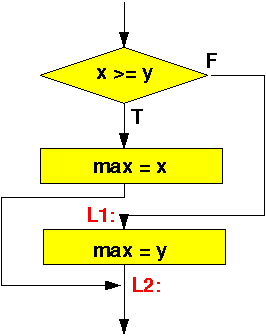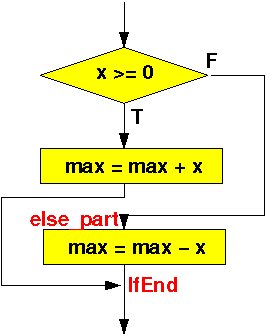if ( condition ) ----> |
statement1; V
else +--------------+ FALSE
statement2; | condition |--------+
+--------------+ |
| |
| TRUE |
| |
V |
statement1 |
| |
+---------+ |
| |
| +<---------------+
| |
| V
| statement2
| |
| |
+-------->+
|
|
V
Evaluate "condition" (CMP)
FALSE
Branch on the FALSE outcome of "condition" to here (A:) ----+
| |
| (TRUE) |
| |
V |
"statement1" assembler code |
|
Branch always to here (B:) ---------+ |
| |
| |
A: "statement2" assembler code <--------------------------+
| |
| |
B: +<--------------------------+
|
V
int x; Assembler construct for this if-statement:
int y;
int max;
if ( x >= y ) MOVE.L x, D0
max = x; CMP.L y, D0 Compares x against y
else BLT L1 Skip when x < y
max = y;
MOVE.L x, max
BRA L2 Must skip over else part !
L1: MOVE.L y, max
L2:
The flow chart of the above program is:

|
- Program:
- Given 2 variables:
- int max
- int x
(with some initial values).
Add the absolute value of x to ax
- Given 2 variables:
- Program in Java:
if ( x >= 0 ) max = max + x; else max = max - x;The flow chart of the above program is:

- Program in M68000 assembler code:
move.l x,d0 cmp.l #0,d0 * Computes: d0 - 0 = x - 0 blt else_part * if ( x - 0 < 0 ) branch to else_part * ------------------------ Continue if blt fails to branch * This happens if x-0 >=0, or: x >= 0 then_part: move.l max, d1 add.l d0, d1 move.l d1, max bra IfEnd branch over ElsePart to continue at IfEnd * (Otherwise we execute the ELSE part !!!) * ------------------------ Arrives here if we branched * This happens when x-0 < 0, or: x < 0 else_part: move.l max, d1 sub.l d0, d1 move.l d1, max IfEnd: (program continues here if there are more statements...)
- Example Program:
(Demo above code)

- Prog file: click here
How to run the program:
- Right click on link and
save in a scratch directory
- To compile: as255 if-else2
- To run: use m68000